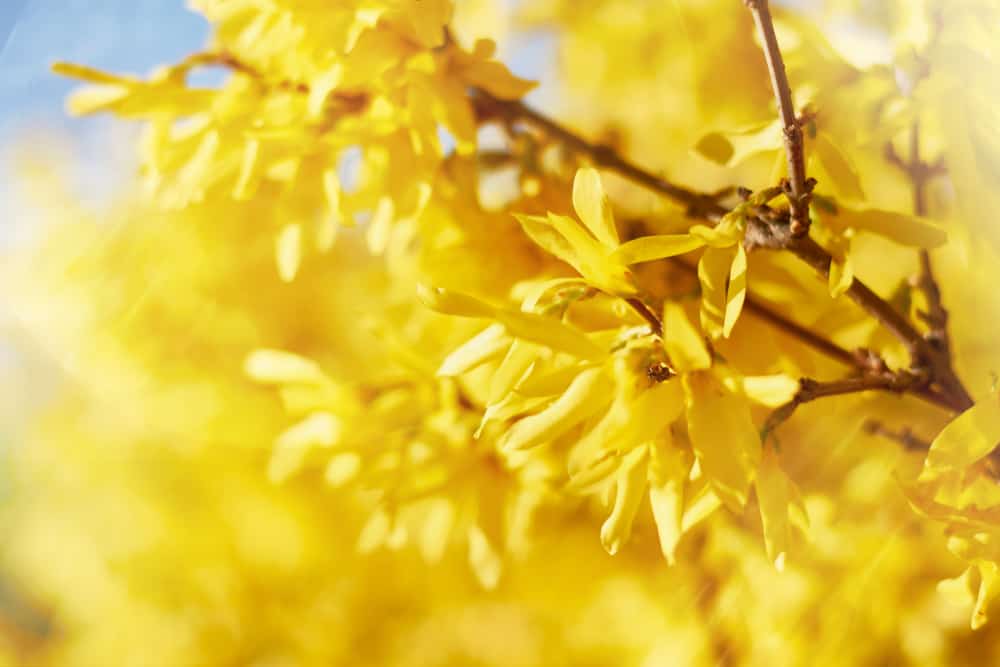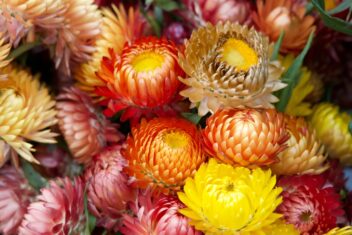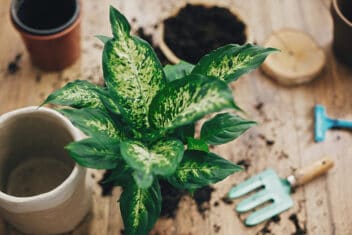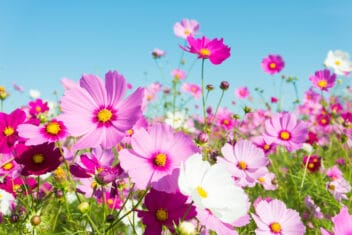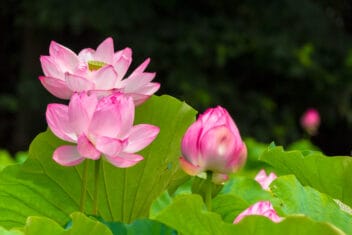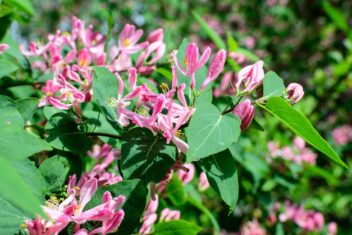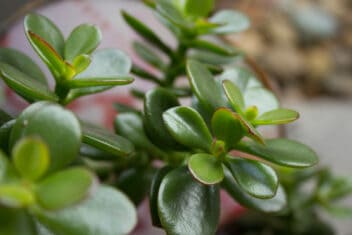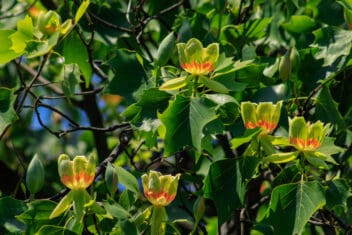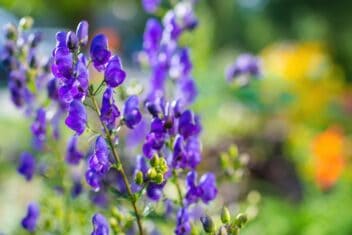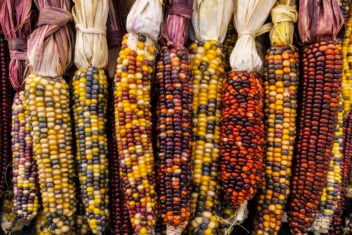The first sign that spring has arrived is when you spot eye-catching forsythia shrubs bursting with color. It’s hard to miss those vibrant yellow forsythia growing out there, especially when the rest of the world is still in winter slumber.
Since 1908, when the first horticultural variety was imported into America, gardeners have been obsessed with growing this plant in their gardens.
Are you looking for some spring color? Then keep reading to learn more about forsythia and growing it at home.
What Is Forsythia?
Forsythias are fast-growing shrubs that belong to the Oleaceae (olive) family. The first known species brought to Europe was the Forsythia suspensa var. sieboldi. Then, a second species was brought over from China called the Forsythia viridissima in 1844.
Many cultivars of this plant have been developed in the subsequent years.

Here are some of the most common forsythia varieties.
Bronxensis
This dwarf F. viridissima cultivar is perfect for creating a low border around your garden, as they only grow a foot tall and a few feet wide. It blooms in March or April and the leaves turn purple in fall.
Fiesta
‘Fiesta’ is a hybrid (F. x intermedia) that can grow up to three feet tall and four feet wide. This variety blooms in late winter, which makes it one of the earliest bloomers amongst forsythia.
You can spot ‘Fiesta’ shrubs by their distinctive red stems and yellow, green, and cream foliage. The leaves turn purple when the growing season ends in the fall.
Border
As a cross between F. suspensa var. sieboldi and F. viridissima, this hybrid is famous for its considerable height, bright color, and rounded shape. It can reach up to ten feet tall and 12 feet wide, with lovely arching branches.
For people looking for an expansive shrub will vibrant flowers, this is a good option.
Kumson
Unlike the other forsythia varieties, ‘Kumson’ (F. viridissima var. koreana) is unique. It has green leaves with contracting veins of cream and almost silver tones.
The leaves will turn brown in autumn and have dark purplish-brown stems. So, even when the plant goes leafless in winter, you can still admire the lovely branches.
Meadowlark
This forsythia shrub is one of the most cold-resistant of the entire species. It’s a hybrid between the F. ovata and F.europaea and can be grown in Zone 3. Other varieties of forsythia usually grow in Zones 5-8, where the weather is more temperate.
‘Meadowlark’ can also grow up to ten feet, making it great as a hedge.
Sunrise
A “semi-compact” grower, this forsythia is late winter to early spring selection. The branches grow upright which sets them apart from other varieties.
The foliage on F. x intermedia ‘Sunrise’ turns to a deep purple in autumn.
Lynwood Gold
This shrub reaches a height of six to eight feet and has branches that grow upward. The golden blossom provides a splash of color to your garden and is excellent as a stand-alone plant.
You can grow F. x intermedia ‘Lynwood Gold’ near other plants to create a contrast in textures and colors.
Some other favorite cultivars of forsythia are:
- Northern Gold
- Karl Sax
- Goldilocks
- Beatrix Farrand
Planting Forsythia
These shrubs are best planted in fall or early spring.
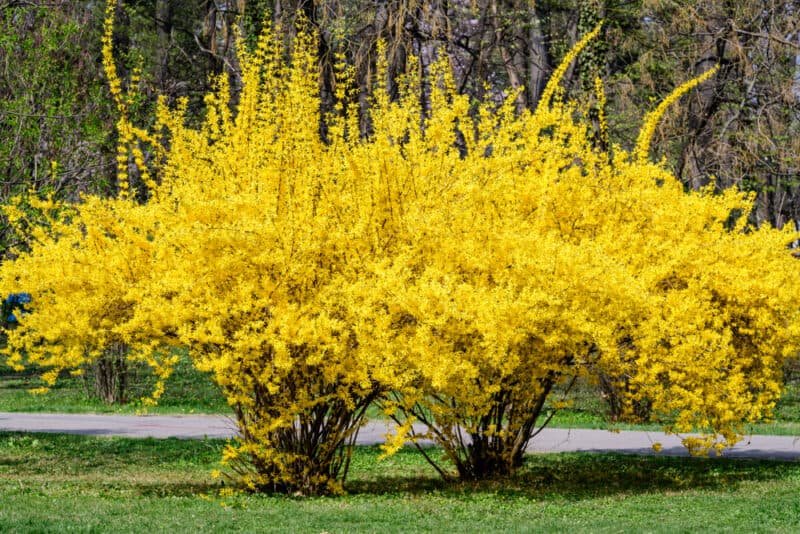
Forsythia shrubs need to grow in a location with at least six hours of direct sunlight daily. They can survive in less light, but they won’t bloom well.
Soil
The best type of soil for growing forsythia is well-draining and loose. It’s also possible to grow forsythia in clay soil. This plant thrives in soil pH levels between 6.8 and 7.7.
The soil must be well-draining, so amend compacted soil with compost or mulch.
Temperature and Humidity
Ideally, forsythias should grow in averagely humid environments. If the humidity is too high, there’s a higher chance of disease. These plants grow in USDA Hardiness Zones 5-9.
However, there are a few hardy varieties that can withstand colder temperatures.
Planting
Most people like to plant forsythias in spring after the last frost. Although, early to mid-fall is also great when the weather is not too warm.
Depending on the size of your shrub, you should leave enough room from one plant to another, or between a structure. Generally, a space of eight feet is perfect for wider varieties.
When you order online, you will most likely get bare root forsythias. Plant these with the root ball under the soil and the crown at the soil level.
To plant, dig a hole twice as wide and deep as the root ball or growing container.
Set the plant into the soil and cover it with soil and organic compost. Water well.
Caring for Forsythia Plants

Forsythia do best with moderate moisture, so watering should be a regular part of your schedule when looking after this shrub if Mother Nature doesn’t provide it.
When your plant is young, take care to ensure that the soil remains evenly moist but not soggy or wet. The moisture levels are more crucial when the plant is young or recently planted.
When forsythia is established and has been growing for a while in the same spot, it can survive a brief drought.
Fertilizer
Fertilizing should not occur until your forsythia bush is one year old. After one year, apply a mild, all-purpose fertilizer at the base of the shrub once a month during spring and summer.
Common Pests and Diseases
Forsythias shrubs are generally tough and don’t get infected by many pests and diseases. There are only a few issues to be aware of when growing this plant at home.
Pests
The brightly-colored flowers attract butterflies, bees, and other wildlife, both good and bad.
The best way to prevent pests from destroying your forsythia plants is to do general maintenance around your garden to pick up leftover debris. This removes breeding areas and places for the bugs to hide.
Tarnished Plant Bugs

Look out for tarnished plant bugs (Lygus lineolaris). They like to eat the flowers when they’re in bloom.
These insects are copper brown and have white marks behind their heads. It’s hard to miss them. They lay their eggs in the plant tissue, and the eggs hatch after five days. Then, they feed on the plants using their sucking mouthparts.
This feeding causes stunted growth, distorted new growth, and ragged leaves and flowers.
Keeping weeds and debris away is the best way to prevent these bugs. There isn’t a good control method, so hand-pick any you find and drown them in soapy water. A forsythia that is happily growing won’t die from an infestation, but it might look ugly.
Two-Banded Japanese Weevils
Another insect that can damage your forsythia plant is the two-banded Japanese weevil (Pseudocneorhinus bifasciatus). The first signs of this pest are when parts of the foliage are missing and the margin of the leaves have holes. These pests are most active in spring.
The weevils drop from the plant when disturbed, so use this to your advantage. Place a tarp or cloth under the plant and shake it vigorously. The weevils will drop down and you can gather them up and drown them in soapy water.
Diseases
The primary disease that can infect forsythia plants is crown gall, caused by the bacteria Agrobacterium tumefaciens or a fungus in the Phomopsis genus.
You can spot this disease when tumor-like balls appear on the stems. The growth beyond the galls is usually stunted and weak.
There is no cure for this disease, but you can remove the galls or heavily impacted branches on established plants. Dig up and dispose of badly infected plants.
Using Forsythia
Surprise! Forsythia is edible. Most people are growing forsythia for the decorative element, but you can eat the flowers and young leaves. Both are fairly bitter, so sample a bit before you fill an entire salad with them.
Sprinkle them over a salad for lunch or use them as a garnish for evening meals.
After the flowering season has ended, small nut-like capsules will be left on your plant. As the fruit is high in oleanolic, it is said to help maintain healthy blood pressure.
Weeping forsythia (F. suspensa) is an important plant in Chinese medicine, which utilizes the plant’s fruits. Forsythiae Fructus (FF) is the dried fruit of the forsythia shrub and the part that is most used in Chinese medicine.
It is thought that the fruit, called Lian Qiao in Mandarin, can cure colds, fevers, and sore throats.
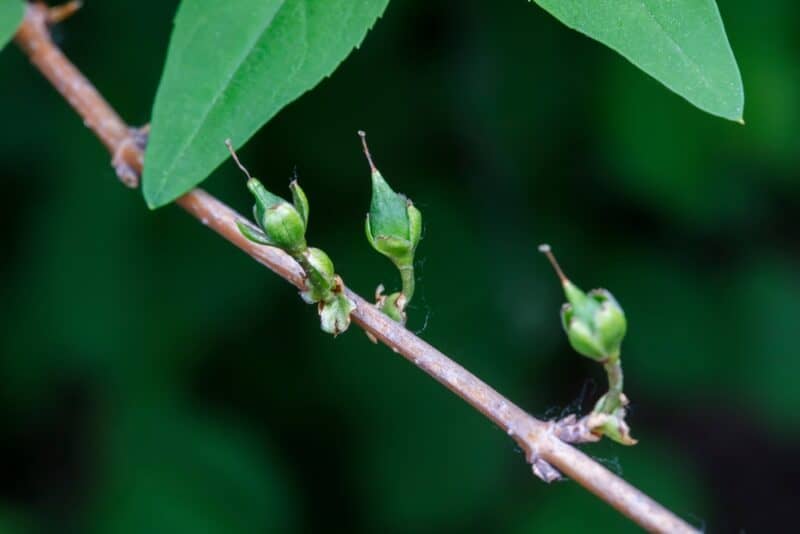
The flowers contain rutin, a nutritious compound with powerful antioxidant properties, as a study in the journal Molecules shows.
The flowers can be used to brew tea when you have a cold or flu. Additionally, you can use the flowers to make syrup. To do this, follow this recipe:
- 3 cups of forsythia flowers
- 3 cups of water
- 3 cups of sugar
Boil the sugar and water together until the sugar dissolves. Let it cool, add the flowers, and let them steep in the sugar water for 24 hours. Strain the flowers before you use the syrup.
